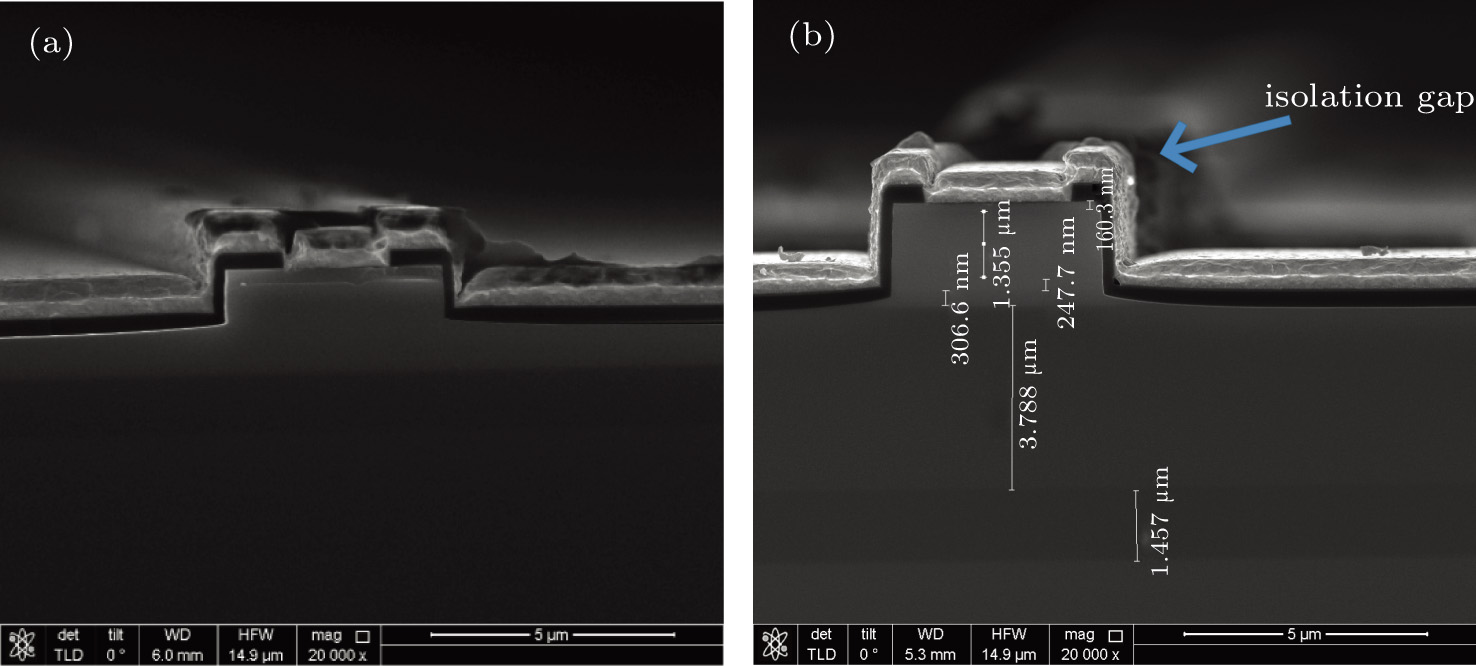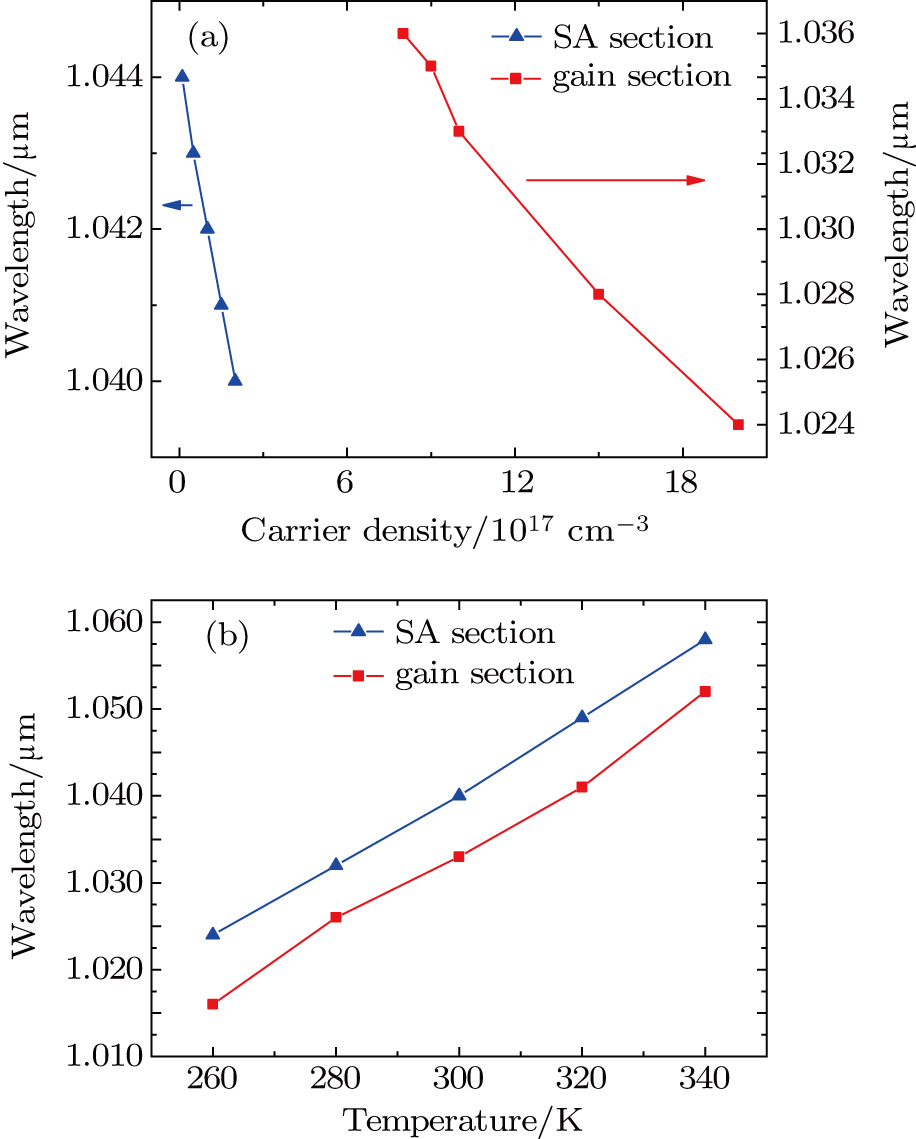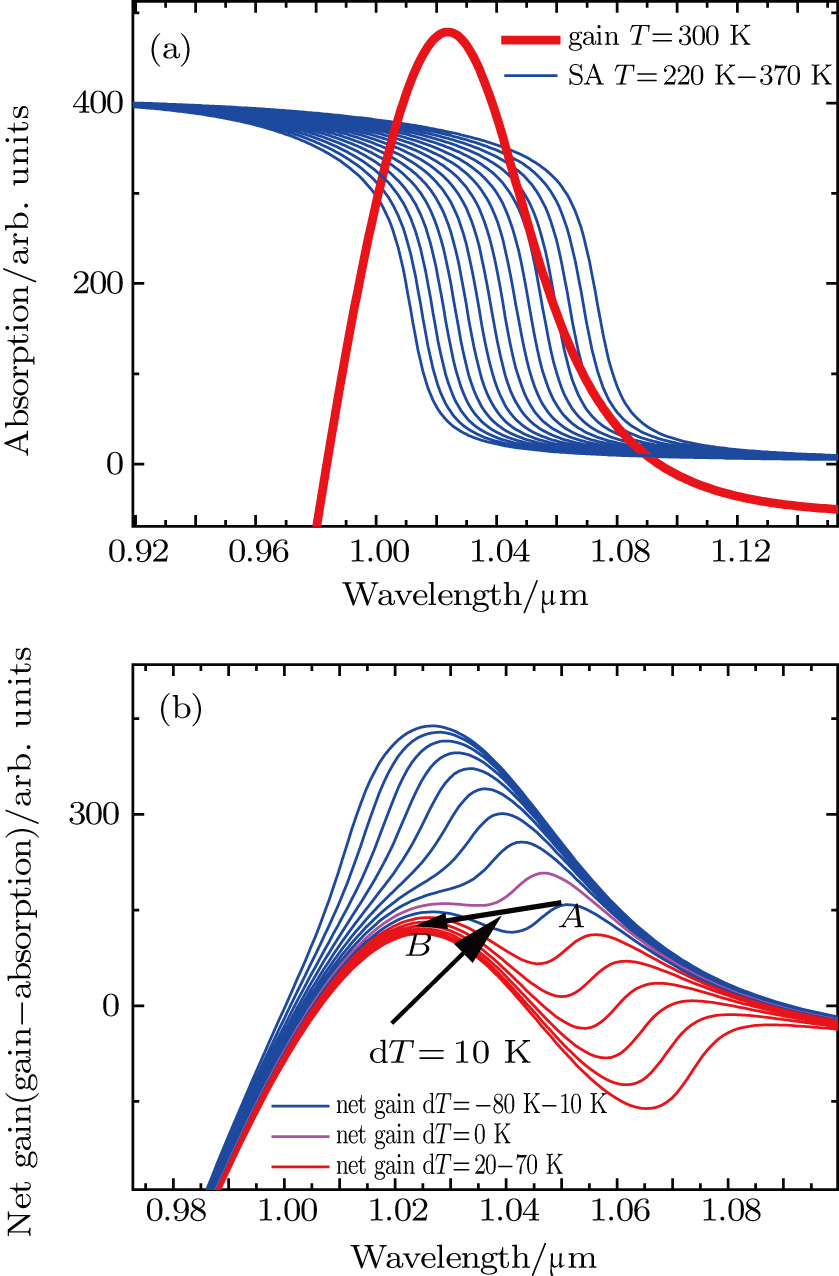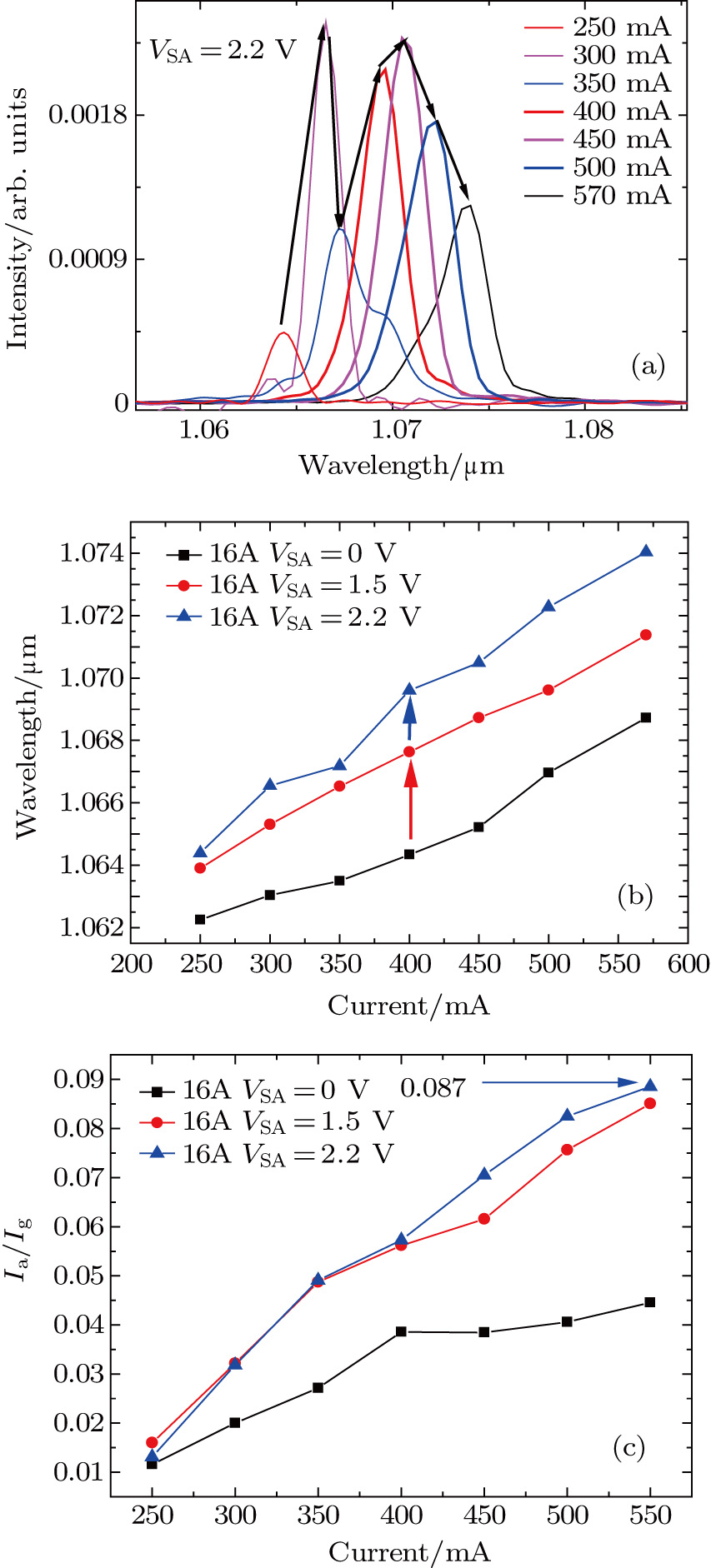† Corresponding author. E-mail:
Project supported by the National Basic Research Program of China (Grant Nos.~2013CB933304 and 2012CB932701), the National Natural Science Foundation of China (Grant Nos. 61274125 and 61435012), and the Strategic Priority Research Program (B) of the Chinese Academy of Sciences (Grant No. XDB01010200).
In this study, two-section mode-locked semiconductor lasers with different numbers of quantum wells and different types of waveguide structures are made. Their ultrashort pulse features are presented. The spectral dynamical behaviors in these lasers are studied in detail. In the simulation part, a two-band compressive-strained quantum well (QW) model is used to study thermally induced band-edge detuning in the amplifier and saturable absorber (SA). A sudden blue shift in laser spectrum is expected by calculating the peak of the net gain. In the experiment part, the sudden blue shift in the emission spectrum is observed in triple QW samples under certain operating conditions but remains absent in single QW samples. Experimental results reveal that blue shift phenomenon is connected with the difference between currents in two sections. Additionally, a threshold current ratio for blue-shift is also demonstrated.
There is an increasing interest in nonlinear optical physics when continuous-wave (CW) pump sources are replaced by ultrafast mode-locked lasers, especially in quantum optics.[1,2] Utilizing ultrashort and ultrafast laser pulses in spontaneous parametric down-conversion (SPDC) and optical frequency conversion is not only showing advantages in lab experiments, but also displaying potentials in integrated quantum information applications.[3,4] Usually such high-energy optical pulses are offered by large optical equipment,[5,6] however it can be replaced by semiconductor laser diodes (LD) if nonlinear materials like PPLN with large secondary nonlinear factor are used.[7] Furthermore, in the quantum optics field where pump pulses with less power and more speed are desired,[8] monolithically fabricated semiconductor mode-locked laser capable of operating at GHz speed[9,10] becomes a promising candidate. With compact structure and low cost, it is also desired in other applications including noninvasive biological imaging,[11] data communication, optical clocking, high-speed optical sampling, all-optical clock recovery, and microscopy.[12,13]
Researchers have been investigating two-section mode-locked lasers for years. Several optimized structures[14,15] and the corresponding models have been developed.[16,17] Recently, mode-locked regimes, noise characteristics, pulse widths, and output powers of these monolithically fabricated lasers have been studied and demonstrated in detail.[18,19] However, as an imperative parameter in frequency conversion, emission spectrum is less mentioned and modeled. A few excellent works show that band-edge detuning in two sections is accountable for the unique spectrum characteristics of these LDs.[20,21] In these works, by taking the absorber as a low pass filter, an easy way to understand spectral dynamical behaviors in similar two-section structures is achieved.[22] As wavelength characteristics around threshold current have already been studied in detail, in this paper a spectrum far above threshold current is modeled and tested. Experiment results are demonstrated in Sections
Practically, the active layers of two sections are the same materials because the laser diodes are made from one single wafer. Therefore, considering null electrical and thermal interactions between two sections, it is reasonable to discuss them with the same two-band compressive-strained quantum well model.[23] Parameters are shown in Table
During the simulation, a single compressed 6 nm In

The parameters in two-band compressive-strained quantum well model.
| Symbol | Value(InAs) | Value(GaAs) | Units | Meaning |
|---|---|---|---|---|
| d | 6.0584 | 5.6533 | Å | crystal distance |
 |
8.329 | 11.88 |   |
elastic stiffness |
 |
4.526 | 5.38 |   |
elastic stiffness |
| a | –6.0 | –9.77 | eV | deformation potential |
| b | –1.8 | –1.7 | eV | deformation potential |
 |
20.4 | 6.85 | – | Luttinger constant |
 |
8.3 | 2.1 | – | Luttinger constant |
| mc | 0.023 | 0.067 |  |
conduction band electron mass |
 |
 |
valence band heavy hole mass on growth plane | ||
 |
 |
valence band heavy hole mass vertical to growth plane |
 |













 |

Normally, the emission wavelength of an operating laser diode is corresponding to the peak of its net gain spectrum. The situation is more complicated in two-segment lasers, where net gain spectrum can be manipulated by its modulation section. Therefore it is necessary to analyze the gain spectrum of the amplifying section and the absorption spectrum of absorber section simultaneously. The temperature dependence of In

 |


Temperature rising depends on the heat generated by Joule effect,[28] which is proportional to 
 |
 |
 |









 |






In the experiment, two-section lasers designed based on the above model were grown by MBE on 2 degree off-cut Si-doped GaAs substrates. The active region of the laser structure was a 6 nm thick compressed InGaAs quantum well buried in the middle of 40 nm GaAs barrier, with two 200 nm undoped GaAs waveguide layers and two 1400 nm highly-doped AlGaAs cladding layers on both sides of it for optical and electrical confinements. All layers were grown at 873 K except the thin InGaAs quantum well layer which was grown at 773 K.
After single QW sample 16A was grown, the wafer was processed into a laser chip with 4.5 μm wide and 2.1 mm long ridge waveguide structure. The 2.1 mm long cavity was separated by a 2000 μm gain section, a 70 μm absorber section, and a 40 μm passive section through conventional chemical etching techniques. A processed wafer was cleaved with both facets uncoated and soldered to the copper heat-sink for testing. The pulse widths, radio frequency (RF) signals, and optical characteristic measurements were carried out by APE intensity autocorrelater (IAC), 50 GHz radio frequency (RF) analyzer, optical spectrum analyzer (OSA), and Fourier transform infrared spectroscopy (FTIR) after laser output was coupled to a 3-meter long single mode fiber. During the experiment the heat sink temperature was set to 20 °C.
The scanning electron microscope (SEM) image of 16A is shown in Fig. 



 | Fig. 3. (color online) Scanning electron microscope (SEM) image of cross section of 16A (a) and 23A (b). The isolation gap can be seen in 23A. |
 | Fig. 5. RF spectrum shows a 17.3 GHz fundamental frequency signal at 500 mA injection current and 2.2 V reverse bias. |
The small current generated in the absorber of 16A was partly due to the thin active layer as well as the small optical confinement and partly due to the short absorber length. In order to achieve blue shift, we modified the absorber structure to manipulate the current generated in it. Three quantum wells laser samples were carefully designed and grown. Samples 10A and 10B were made from the same wafer, which had the similar epilayer structure as 16A except three 6 nm quantum wells in the middle. Sample 23A was similar to 10A and 10B except that two 200 nm GaAs waveguide layers were replaced by a 3000 nm AlGaAs layer. The wafers above were processed into a laser diode. Three samples were made during fabrication, sample 10A with 2000 μm gain section, 70 μm absorber section, and 40 μm passive section, sample 10B with 1770 μm gain section, 300 μm absorber section, and 40 μm passive section, sample 23A with 1770 μm gain section, 300 μm absorber section, and 40 μm passive section. They were cleaved to diodes with both facets uncoated and tested under the same condition as 16A.
The SEM image of 23A is also shown in Fig. 
The first clue of enhanced absorption in 10B is that the reverse bias of 10B drops considerably from around 2 V to below 1 V compared with 10A when LD is mode-locked. For 23A which has less optical confinement than 10B and longer absorber length than 10A, the reverse bias is between 10A and 10B. Therefore the absorption of the absorber section increases with its length and decreases with its optical confinement. Spectrum and current measurements for each sample are carried out in the same way. Results of 10A and 10B are shown in Fig. 

Current ratio of 10A is concluded in Fig. 


Current ratio of 10B is illustrated in Fig. 







 |


Single quantum well sample 16A has less optical confinement than multiple quantum well samples 10A, and therefore we cannot distinguish the influence of quantum well numbers and optical confinement on 








In summary, InGaAs/GaAs based quantum well lasers with four distinctive structures are made and ultrafast output pulses below 10 ps around 1.064 μm are obtained. Output wavelength shows constant red shift in single quantum well samples and sudden blue shift in three quantum wells samples. A model to clarify the phenomenon is made. During the experiments, blue shift shows a direct connection with the current ratio in two sections. Thermally induced band gap shifts of two sections are accountable for this sudden blue shift. The threshold ratio for blue shift increases with absorber length and decreases with optical confinement. Furthermore, wavelength jump and mode locking are not necessarily connected from the above point of view. Samples of one quantum well and three quantum wells showing different spectral dynamical behaviors are both successfully mode locked. However, the influence of thermal band-edge detuning on quality of mode locking in two-section mode-locked lasers should not be overlooked.
| [1] | |
| [2] | |
| [3] | |
| [4] | |
| [5] | |
| [6] | |
| [7] | |
| [8] | |
| [9] | |
| [10] | |
| [11] | |
| [12] | |
| [13] | |
| [14] | |
| [15] | |
| [16] | |
| [17] | |
| [18] | |
| [19] | |
| [20] | |
| [21] | |
| [22] | |
| [23] | |
| [24] | |
| [25] | |
| [26] | |
| [27] | |
| [28] | |
| [29] | |
| [30] | |
| [31] | |
| [32] | |
| [33] | |
| [34] | |
| [35] | |
| [36] |















